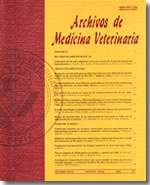Factors associated to lameness in 50 dairy herds in the Xth Region, Chile
Main Article Content
Abstract
The aim of this study was to determine the risk factors related to the prevalence of foot lesions in 50 dairy farms in three provinces (Valdivia, Osorno and Llanquihue) of the Xth Region, Chile. Each farm was visited once between April and July, 2004. During each visit, all lactating cows were observed during locomotion. In those cows showing a degree of lameness, all four feet were examined. The degree of lameness was scored in scale of 1 (slightly lame) to 4 (very lame). Data were recorded in an individual recording sheet for each cow. All the facilities and paddocks where the cows were kept were inspected during each visit. A questionnaire was handed to the manager or the owner of the farm. All the data recorded and the answers to the questionnaire were introduced in an Excel spread sheet as numerical variables and analyzed using the statistical program SPSS 8.0. Risk factors for the four more prevalent causes of lameness were determined using a logistic regression model. The associated factors for an increase of the prevalence in the dairy herds were determined with a multivariable linear regression model. A total of 7501 dairy cows were observed, with 641 of them being diagnosed with some degree of lameness. Cows with three or more lactations were 3.8 times more likely to develop chronic lesions of the hooves and cows with two lactations were 2 times more likely to develop overgrowth of the sole, compared with other lactations. German Red-pied cows were 1.7 times more likely to have white line lesions and 2 times more wall lesions than other breeds. Three risk factors related to lameness were identified: i) changing the diet 25 days prior to calving vs changing the diet nearer to calving date or not changing the diet, ii) concrete roads vs gravel and mud roads, iii) the absence of a footbath versus the presence of a footbath.

